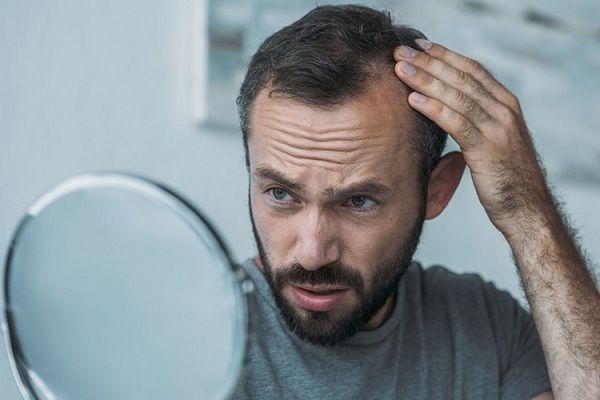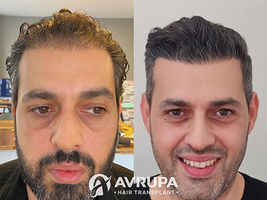
Pimples after hair transplant are one of the potential side effects after hair transplant. They occur due to different reasons and come in different forms. In fact, they can be caused by poor hygiene, overly opened incisions, or simply hair regrowth.
The presence of these pimples is temporary and natural, so you should not be alarmed if you notice them. But you should always inform your attending physician.
Usually, scalp pimples after a hair transplant vary from person to person, but usually, they occur within the first 4 or 5 months after the operation.
Under no circumstances should patients try popping pimples after hair transplant on their own as this could lead to inflammation, infection, or damage to the follicular units.
Pimples can appear in 30% to 40% of patients and will not affect the end result if treated properly. See hair transplant results in detail here.
Types of Pimples After Hair Transplant
The phenomenon of pimples after hair transplant surgery can manifest itself for various reasons and in different forms. If you notice such irregularities in the dermis, you should consult your doctor and not attempt to squeeze them to remove the pus inside.
As this will damage the result of the transplant and possibly lead to infections. Therefore, the best thing to do is to consult a doctor and follow his/her advice.
Among the different shapes of pimples, we can list the following:
- Buttons
- Dermoid cyst
- Folliculitis
1. Buttons
Pimples after hair transplantation do not occur in all patients and can have different reasons. Their nature is often the same. When hair grows back, it collides with the dermis and creates a growth that can also be filled with certain epidermal fluids (pus). These pimples can occur in both donor and recipient areas.
2. Dermoid cyst
Dermoid cysts are caused by the late growth of the transplanted follicles because it has remained abnormally deep in the scalp. This happens because the canal is opened too deep.
This form of pimples after hair transplantation is the least known, but it can rarely occur. This usually happens a few weeks after the hair transplant and in this case, the doctor (not the patient) should open and empty it.
In order to avoid these kinds of pimples after a hair transplant, the canals must be opened properly during the operation. Opening the canals is probably the most important part of a hair transplant and should be done by a professional doctor.
3. The presence of folliculitis
Folliculitis is a bacterial infection of the dermis. This is particularly an infection of the hair follicle. This can occur both in the donor area and in the transplanted area.
This form of pimple after hair transplant surgery usually occurs due to a lack of cleanliness and hygiene. Therefore, bacteria accumulate outside the hair follicle. The main causes of folliculitis are dirt, sweat, and bacteria. These pimples are red and bulging. Folliculitis can be itchy and mild.
In order to prevent the occurrence of folliculitis, it is very important to wash the transplanted area regularly and keep it clean.
What Causes Pimples After Hair Transplant?
The causes of pimples after hair transplant can be multiple. It is therefore important to take a series of precautions after transplantation to avoid the occurrence of this form of skin inflammation. Among the different causes are:
- Hair growth
- Ingrown hair
- Channels (incisions) opened too deep
- Lack of hygiene
- Excessive sebum production
1. Hair Growth
Hair growth can sometimes collide with the dermis. This can lead to small forms of swollen bumps such as pimples. In this case, we see the hair continue to grow as it breaks the dermis and comes out of the pimple itself.
This is the most common cause and resolves over time. It is important not to interfere in any way and not to touch the area or try to pop these pimples.
2. Ingrown hair
Ingrown hairs are another cause of pimples after hair transplantation. They occur if the hair, during its growth, comes out of the dermis and collides with it. This keeps the hair inside the scalp causing bumps filled with pus.
It is very important that patients do not touch these pimples, as it may damage the dermis or the follicular unit itself. Instead, they should go directly to the doctor who will deal with the situation in the best way.
3. Channels too deep
During the transplant operation, the doctor opens channels into which the follicular units will be transplanted. It could, however, by mistake, go too far. In this case, the hair follicle will in turn be positioned too deep.
As it grows, it will collide with the dermis giving rise to a pimple shape after hair transplant. They are generally referred to as ingrown hairs. It is therefore important that a doctor opens the channels and not a technician or a nurse.
Otherwise, the pimple after hair transplant should be opened and emptied by a doctor only.
4. Lack of hygiene
After the hair transplant, there are things to avoid to protect the transplanted area and prevent it from being damaged.
Among the things not to do, we can list anything that could compromise the hygiene of the transplanted area. As it will damage the newly transplanted follicular units.
The lack of hygiene, in fact, allows bacteria to accumulate causing inflammation of the hair follicle. The patient should always keep the transplanted area clean to avoid pimples, infections or inflammation after hair transplantation.
5. Excessive sebum production
Another cause of pimple formation after hair transplantation is the excessive production of sebum from the patient's dermis. It mainly depends on the skin type of the patient.
In this case, it is important for the patient to take special care of their hygiene. This will prevent bacteria from accumulating on the surface of the hair follicle.
When Do Pimples Appear After Hair Transplant?
Pimples after hair transplant occur in the weeks following the hair transplant. In the transplanted area, they usually occur after the phenomenon of loss of shock. During the hair regrowth stage, hair collides with the dermis resulting in the formation of pimples.
Pimples in the donor area after hair transplant always form a few weeks after transplantation.
How to Treat Pimples After Hair Transplant?
In order to treat pimples after a hair transplant, there are certain types of precautions to be taken such as:
- Medical examination
- Antibiotic treatments
- Surgical treatments
1. Medical examination
If you notice the appearance of pimples after your hair transplant, it is important not to touch them or treat them yourself to avoid creating unintentional damage to the dermis or the transplanted follicular unit. But it is necessary to immediately contact your attending physician who, after a thorough visit, will determine the cause and therefore the best treatment
2. Antibiotic treatments
Antibiotics can be prescribed after a thorough visit by your physician. This is assuming that there is a bacterial infection. Antibiotics can be taken orally or topically for about 10 to 14 days.
- Oral
After a thorough diagnosis if the doctor finds that there is a bacterial infection of the dermis, the patient may be prescribed the use of an oral antibiotic. It doesn't happen often, but it is certainly helpful in reducing inflammation.
- Topical
The doctor, after a thorough examination, may prescribe topical antibiotics. These can be creams or gels applied directly to the pimple itself.
3. Surgical treatments
If the pimples after hair transplantation are larger than a chickpea, the doctor should therefore act surgically.
As a result, the pimple will be pierced with a small thin needle and emptied of the infected pus it contains. This promotes faster disappearance of inflammation and healing of the dermis.
Patients should absolutely not attempt to pop or play with the pimples by themselves. It could damage the dermis or the follicular unit transplanted into it.





Share Your Opinion, Please